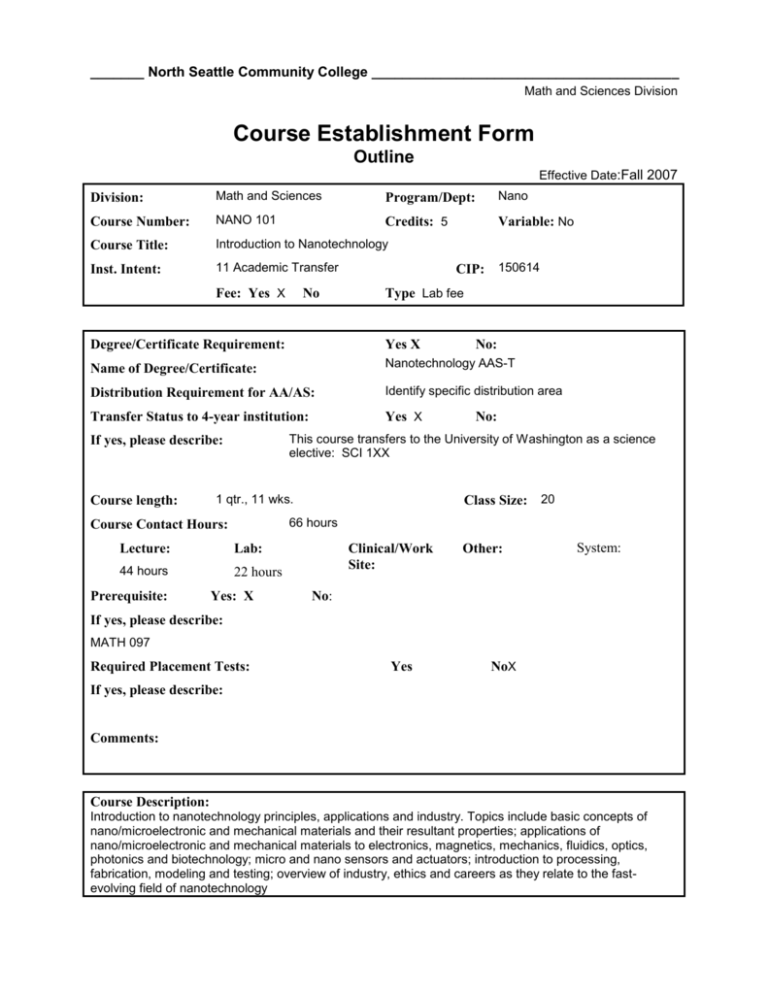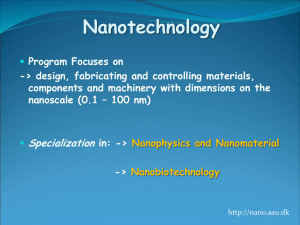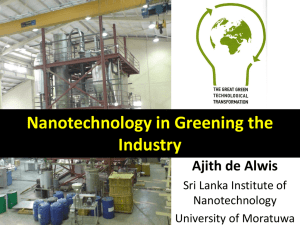NANO 101
advertisement

_______ North Seattle Community College ________________________________________ Math and Sciences Division Course Establishment Form Outline Effective Date:Fall 2007 Division: Math and Sciences Program/Dept: Nano Course Number: NANO 101 Credits: 5 Variable: No Course Title: Introduction to Nanotechnology Inst. Intent: 11 Academic Transfer Fee: Yes X No CIP: 150614 Type Lab fee Degree/Certificate Requirement: Yes X Name of Degree/Certificate: Nanotechnology AAS-T Distribution Requirement for AA/AS: Identify specific distribution area Transfer Status to 4-year institution: Yes X 1 qtr., 11 wks. Class Size: 20 66 hours Course Contact Hours: Lecture: Lab: 44 hours 22 hours Prerequisite: No: This course transfers to the University of Washington as a science elective: SCI 1XX If yes, please describe: Course length: No: Yes: X Clinical/Work Site: Other: System: No: If yes, please describe: MATH 097 Required Placement Tests: Yes NoX If yes, please describe: Comments: Course Description: Introduction to nanotechnology principles, applications and industry. Topics include basic concepts of nano/microelectronic and mechanical materials and their resultant properties; applications of nano/microelectronic and mechanical materials to electronics, magnetics, mechanics, fluidics, optics, photonics and biotechnology; micro and nano sensors and actuators; introduction to processing, fabrication, modeling and testing; overview of industry, ethics and careers as they relate to the fastevolving field of nanotechnology Page 2 NSCC General Education Learning Outcomes and/or Related Instructional Outcomes (for technical courses) Met by Course: Outcome 1. Think critically in reading and writing. Outcome 2. Use quantitative reasoning processes to understand, analyze, interpret and solve quantitative problems. Outcome 10. Identify and understand fundamental concepts of the physical and life sciences and the effects that the uses of these concepts and resulting technologies have on the individual, on society and on the biosphere. Course Outcomes/Learning Objectives: I. Students should be able to relate the basic concepts of quantum, atomic and molecular physics and describe how these rules relate to mechanical, electronic, magnetic and photonic properties of materials. II. Students should be able to list and describe the operating principles behind the most common equipment used in nanotechnology, such as measurement and analysis equipment, thin-film and plasma processing equipment, and chemical and biological processing equipment. III. Students shoud know the industrial areas of application for nanotechnology. IV. Students should have an understanding of the ethical and societal implications of nanotechnology, and be able to appraise and criticize statements about those iimplications. V. Students should know the basic operating protocols in a controlled environment and be able to practice them in a clean room setting. These protocols include safety and contamination control procedures. Topical Outline and/or Major Divisions: I. Background and introduction to nanotechnology A. The periodic table B. Energy, quantum physics and the Bohr atom ` C. Molecules and phases i. Solids ii. Liquids iii. Gases iv. Plasmas D. Vacuum technology E. Top-down and bottom-up nanotechnology II. Molecular nanotechnology and measurement A. Microscopy i. Electron microscopy ii. Ion-beam microscopy iii. Transmission electron beam microscopy B. Atomic force probe characterization C. Spectroscopy D. Self-assembly III. Nanomaterials in bulk forms A. Preparation techniques and tools i. Plasma arcing ii. Thin-film deposition iii. Sol-gels iv. Electrodeposition B. Material property modification IV. Nano electronics and photonics A. Physics of light i. Reflectance, transmission, absorption ii. Refraction iii. Radiation B. Nano materials and light i. Solar energy ii. Light emission iii. Optical thin films C. Electronics i. Background and history ii. Lithography iii. Thin-film deposition equipment iv. Quantum electronic devices V. Chemical – molecular nanotechnology A. Molecular switches B. Molecular manipulators and actuators VI. Carbon nanotechnology A. New forms of carbon B. Formation techniques C. Prpperties and uses of nanotubes VII. Biological nanotechnology A. Introduction B. Proteins C. DNA VIII. Societal impact and the ethics of nanotechnology A. The split between haves and have-nots B. Environmental impact C. Ethics of manipulating DNA IX. Future applications A. Micro and nano machines B. Nanocomputing C. Active materials X. Controlled environments A. Clean rooms B. Biological environments and sterile technique C. Safety and lab protocols Course Requirements (Expectations of Students) Participate in class and lab activities. Complete assigned work, take scheduled exams and quizzes, and be prepared to present concepts and topics that have been covered to the class orally or in written form. Students will be expected to demonstrate the ability to perform specific competencies listed under “Course Outcomes/Learning Objectives.” Methods of Assessment/Evaluation: 1. Exams 2. Homework/quizzes 3. Lab work 4. Participation 5. Special projects Final grades are assigned according to the published grading standards of the course. Required Text(s) and/or Materials: As determined by instructor; an example of a textbook appropriate for this course would be Wilson, Kannangara, Smith, Simmons and Raguse, Nanotechnology: basic science and emerging technologies Page 4 Supplemental Text(s) and/or Materials: As required by instructor. Outline Developed by: Mark Helsel, Jeff Owens Date: 4/5/2005 Outline Revised by: Jim Patterson Date: 5/23/06 Course Establishment Form 2001 le 10/11/01




